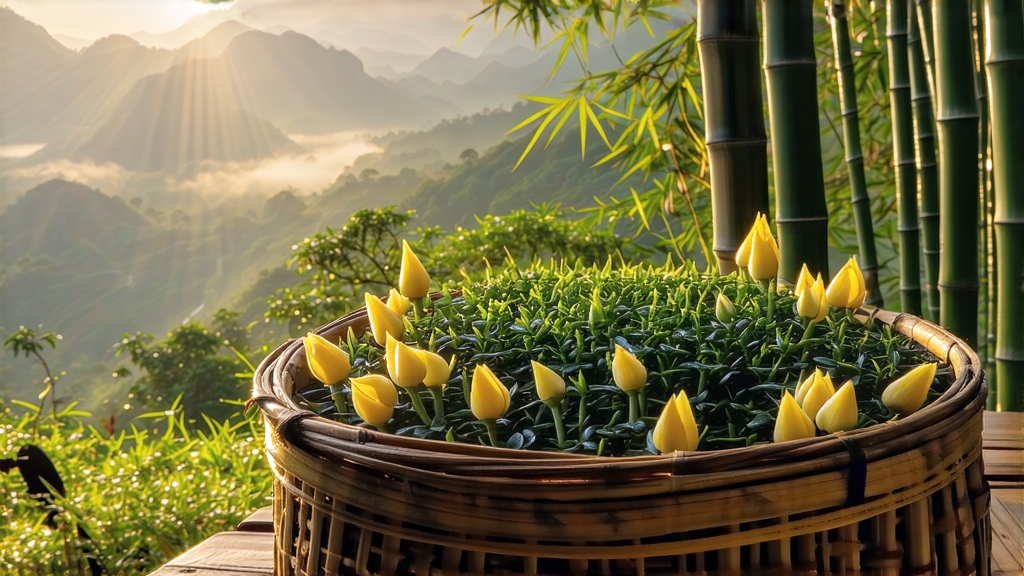
Tucked high above the Sichuan basin, where perpetual cloud veils the Min River gorge, lies Meng Ding Mountain, the cradle of the world’s oldest cultivated tea garden. It was here, in the mist-cooled terraces of Ganlu Temple, that Buddhist monks first coaxed the subtle golden liquor now known as Meng Ding Huang Ya—Meng Ding Yellow Bud. Unlike its green cousin Longjing or the smoky Zhengshan Xiaozhong, this yellow tea has always moved in whispers: a court secret during Tang, an imperial tribute through Song, and by the late twentieth century almost a phantom, produced only in quantities small enough for local scholars and hermits. Yet the very delicacy that pushed it to the brink of extinction is what today captivates global tea hunters searching for a taste that sits mysteriously between green freshness and black warmth.
Historical scrolls kept in the mountain’s cliff-side monastery record that Ganlu (Sweet Dew) tea was presented to Emperor Li Shimin as early as 641 CE. When the Song court moved south to Hangzhou, the mountain’s abbot dispatched 360 cakes of the earliest spring buds, each wrapped in silk and sealed with camphor leaves, along a 1,500-kilometer relay of horse stations. The journey took seven days and seven nights; the tea arrived still cool to the touch, a feat that earned Meng Ding the nickname “flying tea.” During Ming, the cakes were replaced with loose leaf, and the innovative “sealed yellowing” step—men huang—was perfected inside the monastery’s incense-dark storerooms, giving the buds their characteristic primrose hue and mellowing the grassy edge typical of Sichuan greens. By Qing, however, black and dark teas from Yunnan dominated the trade routes; yellow tea retreated into the clouds, produced almost as liturgy rather than commerce.
Meng Ding Huang Ya is not a single cultivar but a micro-ecology. The ancient terraces, now a UNESCO mixed heritage site, host a polyculture of seed-propagated Camellia sinensis var. sinensis bushes interplanted with ginkgo, magnolia, and wild ginger. The understory ginger releases zingiberene into the soil, which the tea roots absorb, adding a faint spicy note that tasters often describe as “mountain ginger flower.” Three clonal selections—Ganlu 1, Ganlu 2, and the rarer Baiya 3—are officially permitted for commercial Huang Ya, yet the most sought-after lots still come from 300-year-old seedling trees that can be pollinated only by the native blue-banded bee, a species active when the spring mists lift for exactly two hours around noon. This narrow ecological window explains why authentic Meng Ding Huang Ya rarely exceeds six metric tons per year, less than one day’s output of a single Fujian oolong factory.
The crafting choreography begins before dawn on the first day after Qingming, when the mountain’s thermometer hovers at 11 °C and humidity at 94 %. Pickers—usually women whose families have worked the terraces for at least five generations—pluck only the unopened spear: a bud and half-embracing first leaf, no longer than 2.5 cm and still turgid with overnight dew. The leaf is deposited into bamboo tubes lined with fresh banana leaf to prevent compression; tubes are then slung across the back with rattan straps so that no metal touches the leaf, avoiding early oxidation. By 8 a.m. the harvest reaches the monastery’s stone courtyard, where it is gently warmed over a pinewood charcoal brazier set into the floor. The heat is not for drying but for “sha qing,” kill-green, yet held at an unusually low 75 °C for exactly 108 seconds, long enough to denature polyphenol oxidase without driving off the aromatic precursors. What follows is the yellow tea signature: men huang, sealed yellowing. The lightly fixed leaf is piled in oak boxes lined with wet hemp cloth, then slid into a cave chamber where temperature is maintained at 28 °C and oxygen kept below 5 % by burning a single beeswax candle inside a sealed terracotta jar. Over 48 hours the leaf slowly suffocates and re-breathes, chlorophyll degrading into pheophytin while amino acids condense into unique lactones responsible for the tea’s hallmark “chestnut-sweet” aroma. Finally the leaf is baked above embers of local walnut wood, whose smoke carries a faint vanillin that marries with